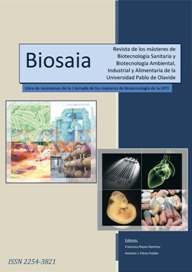Role of Succinate Dehydrogenase D (SDHD) in Hepatocytic Cells
Palabras clave:
Succinate dehydrogenase D, metabolic changes, mitochondriaResumen
Motivation: Mitochondria are the principal site of important cellular functions including ATP production via oxidative phosphorylation (OXPHOS) but also play a central role in cell physiology.OXPHOS comprises five respiratory complexes (RCs). Complex II or succinate dehydrogenase (SDH) is a heterotetrameric nuclear-encoded complex composed of four subunits (SDHA, SDHB, SDHC, SDHD). It´s responsible for transferring electrons into mitochondrial respiratory chain for ATP production but also for the oxidation of succinate to fumarate in the tricarboxylic acid (TCA) cycle.Changes in TCA cycle have been considered as potential mechanisms of aerobic glycolysis that contributes to the alteration of cellular metabolism with implications in tumorigenesis. It has been reported that polymorphisms in SDHD are associated with early recurrence of hepatocellular carcinoma. Our goal was to study the role of SDHD in tumor and no tumor liver cells.
Methods: Murine hepatocytic cells, AML12 and Hepa1-6 were obtained from the ATCC. In order to analyze the function of the SDHD we used murine-SDHD-specific siRNA and control siRNA. SDHD overexpression was performed using a plasmid vectors with murine SDHD constructed using standard molecular cloning techniques. In both cases cells were transfected with lipofectamine.To analyze metabolic changes induced by SDHD we performed real-time PCR. Proteins were examined by Western blots. Cell viability assay, colony formation assay and wound healing assay have been performed to determinate cell survival, proliferation and migration.
Results: Inhibition of SDHD in hepatocytic cells increased glycolytic genes at 48 h and 72 h after transfection compared to controls, with higher rate in the Hepa1-6 than AML12 cells. Overexpression of SDHD, did not induce significant changes in metabolic genes as compared to control cells. Furthermore, we observed that the inhibition of SDHD in hepatocytic cells produced an increase in cell death. In addition, clonogenic growth decreased greatly, resulting in reduced colony size and numbers in SDHD-inhibiting cells. In a wound healing migration assay, cell confluence was reached significantly later in the SDHD-inhibiting cells than the si-control transfected cells. Finally, the cell cycle analyses showed that SDHD-knockdown cells showed less percentage of cells in G1 than control cells.
Conclusions: Our findings suggest that SDHD plays an important role in the survival, growth and cellular proliferation.





